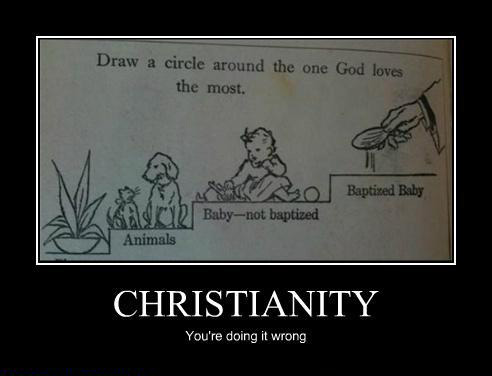"Christ's Life In Us" (Irish schoolbook, 1970)
Rosita Boland,
in
The Irish Times,
23 June 2011
(see
page)
reported on an incredibly offensive old Irish schoolbook
that she had discovered.
When I first saw the image on social media,
it was so bad
that I thought it might be satire.
But it is, incredibly, a real Irish schoolbook from 1970.
I felt the need to see it myself, so I went to see it in the
National Library of Ireland.
It is called
Christ's Life In Us, revised edition, 1970.
The following images are from the
textbook
and the
workbook,
both of which are bound together as NLI item:
Ir 372 c 112.

It's a real schoolbook.

Imprimatur
by
William Philbin,
RC Bishop of Down and Connor.

The textbook absurdly tells children that they were
"born with the stain of Adam's sin".
Despite the fact that it has been known since the 19th century that
Adam never existed.
The book tells children that the unbaptised (i.e. most of humanity)
cannot get to heaven.

This incredibly offensive page is in the workbook.
The Catholic church used to tell innocent Irish children that God loves baptised babies more than unbaptised ones,
who were somewhere between a baby and an animal.

Genuine Irish schoolbook, 1970.
Reaction

Meme found
here.

Parody found here.
Origin unknown.
Refers to the Haldane quote
about God's apparent mania for beetles:
"The Creator would appear as endowed with a passion for stars, on the one hand, and for beetles on the other, for the simple reason that there are nearly 300,000 species of beetle known, and perhaps more, as compared with somewhat less than 9,000 species of birds and a little over 10,000 species of mammals."

Tess is tortured by the thought of her unbaptised baby not going to heaven.
Screenshot of 1998 TV adaptation
of the book
Tess of the d'Urbervilles (1891).
See text of book.
- Tess desperately baptises her baby herself:
"The baby's offence against society in coming into the world was
forgotten by the girl-mother; her soul's desire was to continue that
offence by preserving the life of the child. However, it soon grew
clear that the hour of emancipation for that little prisoner of the
flesh was to arrive earlier than her worst misgiving had conjectured.
And when she had discovered this she was plunged into a misery which
transcended that of the child's simple loss. Her baby had not been
baptized.
Tess had drifted into a frame of mind which accepted passively the
consideration that if she should have to burn for what she had done,
burn she must, and there was an end of it. ... But when the same question arose with regard
to the baby, it had a very different colour. Her darling was about
to die, and no salvation."
- Tess buries him herself, because the church refuses to.
"So the baby was carried in a small deal box, under an ancient woman's
shawl, to the churchyard that night, and buried by lantern-light,
at the cost of a shilling and a pint of beer to the sexton, in that
shabby corner of God's allotment where He lets the nettles grow,
and where all unbaptized infants, notorious drunkards, suicides,
and others of the conjecturally damned are laid. In spite of the
untoward surroundings, however, Tess bravely made a little cross of
two laths and a piece of string, and having bound it with flowers,
she stuck it up at the head of the grave one evening when she could
enter the churchyard without being seen, putting at the foot also
a bunch of the same flowers in a little jar of water to keep them
alive."
- Limbo
- Infant damnation
- How the church tortured women for centuries by telling them
their unbaptised babies would burn, or go to limbo,
or whatever other stuff the church felt like inventing.







